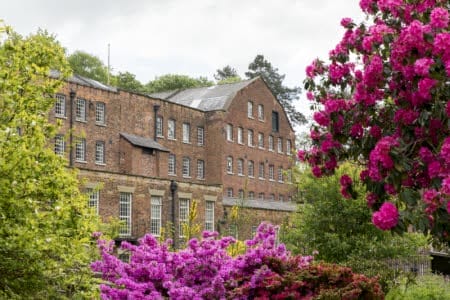NATIONAL TREASURES
The UK is brimming with historic sites, houses and gardens. Karen Evennett takes a look at the organisations behind them


THE NATIONAL TRUST
From the Lizard in Cornwall to Giant’s Causeway in Northern Ireland, more than 780 miles of coastline now come under the protective auspices of the National Trust – along with over 250,000 hectares of land, 500 historic houses, castles, parks, and gardens.
That familiar oak-leaf logo pops up all over the place. A sign that the Trust has achieved what it set out to do 130 years ago – protect the nation’s heritage from industrial changes – and it’s thanks to three enlightened people that we enjoy so much of what the UK has to offer.
Canon Hardwicke Rawnsley, solicitor Sir Robert Hunter and social reformer Octavia Hill – the three founders of the National Trust – shared the belief that nature, beauty and history should be made available for everyone to share. They took on their first piece of land, five acres of clifftop at Dinas Oleu in Wales, in 1895, just weeks after having the National Trust registered under the Companies Act.
The first National Trust property, Alfriston Clergy House in East Sussex, was purchased a year later, for £10. Three years after that, came its first nature reserve – two acres of Wicken Fen, in Cambridgeshire. The National Trust is now the biggest conservation charity in Europe – still protecting green spaces, conserving historic houses and halting the overdevelopment of our coastline.
Over the years it has also responded to the various challenges thrown its way and, with climate change the current biggest threat to nature, homes and habitats, this year the Trust is prioritising restoring nature wherever it can. To do so, its goal is to fundraise more in the next decade than it did in the last century. The Trust’s Adopt a Plot scheme is encouraging people to get involved by sponsoring a plot of land for nature recovery. The first six of these ‘super nature sites’ are Derbyshire’s Peak District, Wallington in Northumberland, Killerton in Devon, Wicken Fen, Eryri in North Wales and Divis and the Black Mountain in Northern Ireland.

THE ROYAL BOTANIC GARDENS
Our Royal Botanic Gardens offer peaceful oases in London, Sussex and Scotland, and a chance to see speciality trees and plants.
Perhaps the most famous of the gardens – reached via its own tube station 500m from the gate – Kew, in West London, started life as the brainchild of Princess Augusta, mother of King George III. It’s now a globally renowned scientific institution for plant and fungal research, but equally famed for its Great Pagoda, its sumptuous glasshouses – including the Palm House, the Temperate House and the Princess of Wales conservatory – and The Hive, a stunning 17m structure that uses sound to recreate life inside a beehive. Your Kew ticket also buys you entry to Kew Palace, one of the six palaces managed by the Historic Royal Palaces charity.
Away from London, in the heart of Sussex, Kew’s sister garden, Wakehurst – home to the Millennium Seed Bank and more than 500 acres of landscapes and plants from across the world – is proud to have actor Cate Blanchett as its inaugural ambassador. Across 2025, both gardens are paying particular homage to trees. From April, visitors to Kew can enjoy The Power of Trees, a brand-new gallery exhibition exploring how trees inspire artists around the world.
From early May, Of the Oak, a largescale installation, marks Kew’s first ever outdoor digital commission, showcasing one of the garden’s most magnificent trees, The Lucombe Oak, via a multisensory journey.
If you’re visiting later this summer, don’t miss Kew’s new Carbon Garden, while in Wakehurst, the Millennium Seed Bank (MSB) celebrates its 25th anniversary with art and soundscapes illustrating the global partnerships that have helped make it what it is today.

ENGLISH HERITAGE
English Heritage started life in 1882 as part of the Office of Works, a Government department dedicated to architecture and building. It acquired its first property, the Neolithic Kit’s Coty House in Kent, in 1883. By 1933 the collection numbered 273 sites – including Rievaulx Abbey, Carisbrooke Castle, Richborough Roman Fort, and Stonehenge, which remains its most visited site to this day. The organisation’s dual role has always been to preserve places of historic interest – and share their stories with the public as a way of bringing history to life.
You can now explore more than 400 English Heritage sites, and stay in 21 selfcatering holiday properties at 15 of the lovely locations, ranging from castle towers to a coastguard’s cottage. When staying in a holiday property, you will be given free entry to English Heritage sites for the duration your stay and 10 per cent discount in English Heritage shops and cafe Five properties have been awarded Visit England’s highest 5-star gold rating: Head Gardener’s House at Audley End, Gardener’s House at Wrest Park, Peverell’s Tower at Dover Castle, Pool House at Witley Court and Prior’s Lodge at Mount Grace Priory.
WOULD YOU LIKE TO ENTER OUR COMPETITIONS?
Giveaways are only available to our Candis members so why not join today!
BECOME A MEMBER